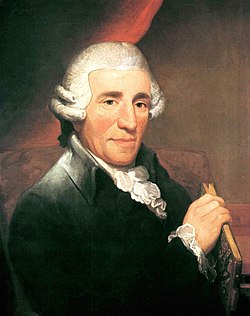Symphony No. 73 (Haydn)

The Symphony No. 73 in D major, Hoboken 1/73, is a symphony by Joseph Haydn composed in 1782. It is often known by the subtitle La chasse (transl. The hunt)[1] due to the hunting horn calls in the final movement, a popular trope in eighteenth century music.[2]
Movements
[edit]The symphony is scored for flute, two oboes, bassoon, two horns and strings. Some versions also include two trumpets and timpani which appear only in the Finale.
The first movement follows a sonata form with a slow introduction. Notably, although the introduction ends on a dominant chord, the Allegro does not open in the tonic key.[3] This movement displays one of Haydn's favorite musical devices, turning accompaniment into melody. Here, this is done in the simplest possible manner by constructing the main theme out of repeated notes. Once the repeated-note theme is established, then any time repeated notes are used in accompaniment, it sounds to the listener like thematic counterpoint.[4]
The second movement is based on Haydn's song Gegenliebe, Hob. XVIIa:16.[1] The song forms the refrain for a rondo. The contrasting episodes of the rondo are derived from the song-melody and are all in the minor.[5]
The final movement was originally composed as the overture to Haydn's opera La fedeltà premiata (“Fidelity Rewarded”), a detail which has helped secure the dating of the symphony.[6] The hunting melody of the finale is a quotation from La Chasse du cerf,[7] a Divertissement for solo voices, chorus, and instrumental ensemble by the eighteenth century French composer Jean-Baptiste Morin. Morin himself drew upon the popular Sourcillade (or Vue) penned by André Danican Philidor in the first decade of the 18th century. Haydn's theme was therefore widely recognisable as a hunting motif.[8]
Along with the famous coda to the Farewell Symphony, La Chasse is one of the few Haydn symphonies to end quietly.[5]
See also
[edit]Notes
[edit]- ^ a b HC Robbins Landon, Haydn: Chronicle and Works, 5 vols, (Bloomington and London: Indiana University Press, 1976-) v. 2, Haydn at Eszterhaza, 1766-1790
- ^ Ringer, pp. 148-159
- ^ Hepokoski, James; Darcy, Warren (2006). Elements of Sonata Theory. New York: Oxford University Press. p. 298. ISBN 978-0-19-514640-0.
- ^ Charles Rosen, Sonata Forms (2nd edition 1988, W.W. Norton & Company, New York, ISBN 0-393-30219-9).
- ^ a b Brown, A. Peter, The Symphonic Repertoire (Volume 2). Indiana University Press (ISBN 025333487X), pp. 187-194 (2002).
- ^ [I]l est possible de déterminer quelques dates post quem grâce à des oeuvres antérieures, datées (notamment des ouvertures d'opéras), qui seront reprises plus tard, plus ou moins modifiées, comme mouvement de telle ou telle symphonie (ainsi, par exemple, l'ouverture de La fedeltà prenziata, opéra composé par Haydn en 1780, sera ensuite utilisée comme finale de la symphonie no 73 La Chasse). Jean Gribenski, Review Haydn-Studien II, Hefte 1 & Haydn-Studien II, Hefte 2, Revue de musicologie, T. 56e, No. 1er. (1970), pp. 99-104. Quotation, 102.
- ^ This little cantata "sung before the king at Fontainebleau in 1708" ... describes the typical series of events during a whole day of hunting, introducing a great number of sonneries, from the morning's Reveil to the final Halali. On p. 111 of the score published in 1709 there appears a melody [i.e. the Sourcillade] by Philidor. Ringer, 150.
- ^ Ringer, 150.
References
[edit]- Alexander L. Ringer, The "Chasse" as a Musical Topic of the 18th Century, Journal of the American Musicological Society, Vol. 6, No. 2. (Summer, 1953)


 French
French Deutsch
Deutsch